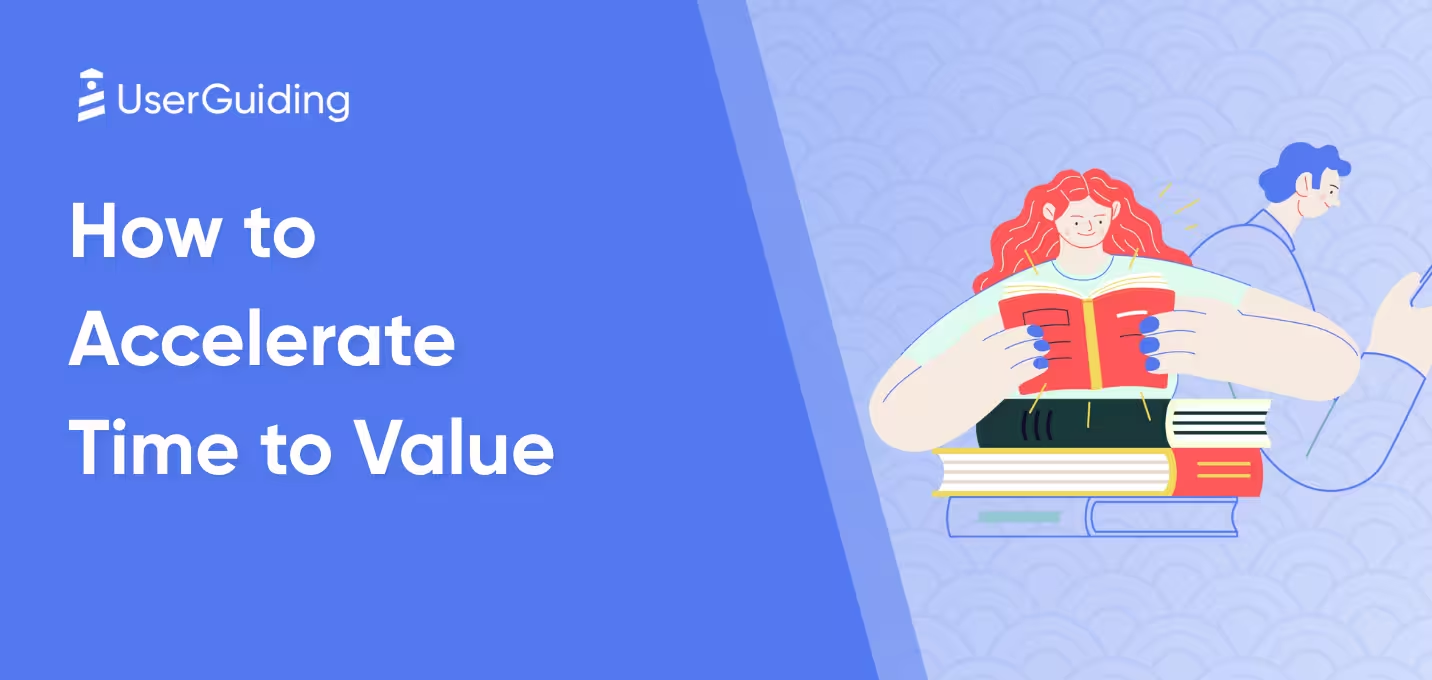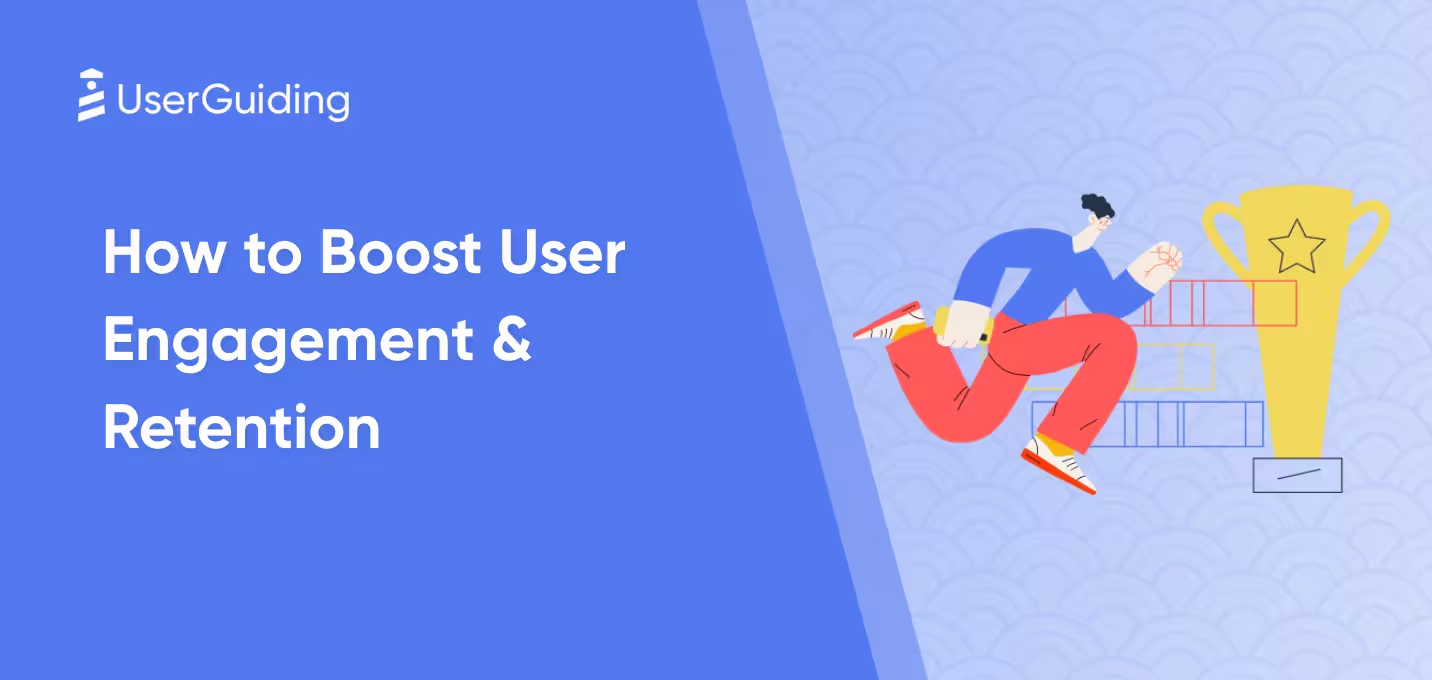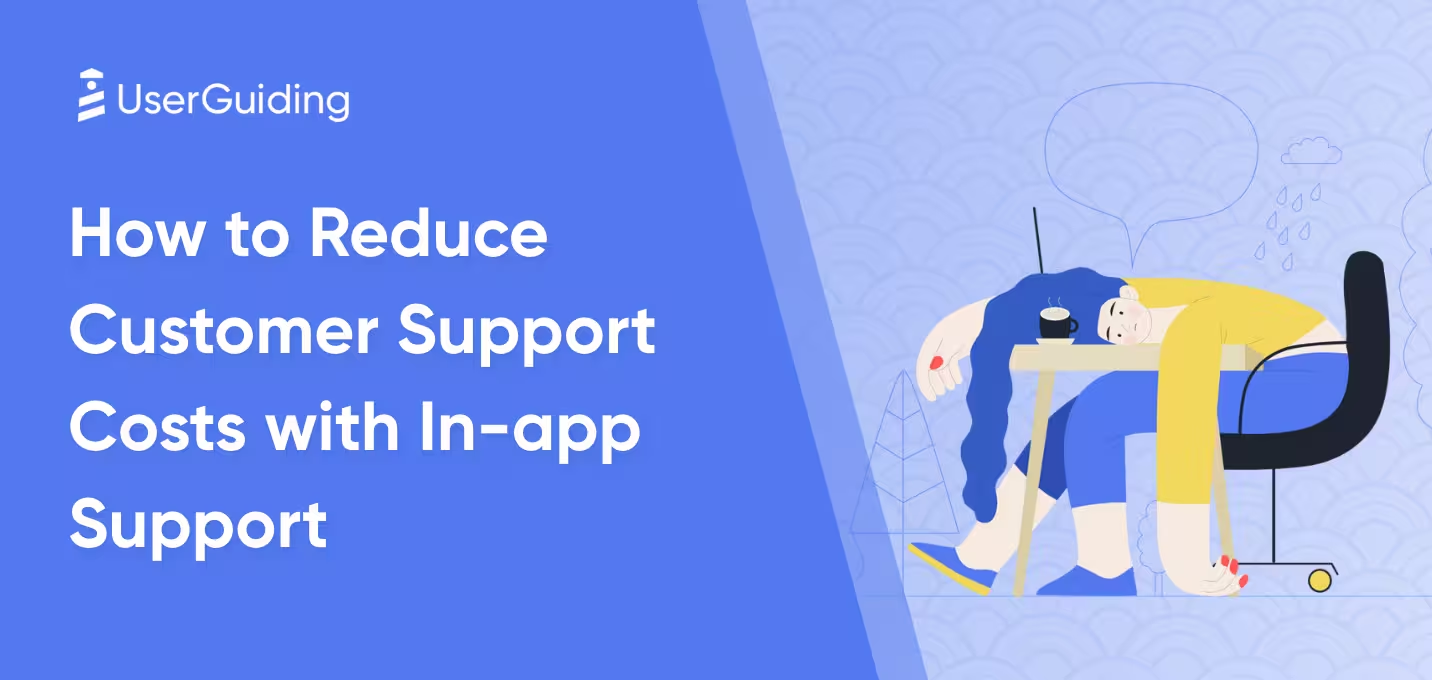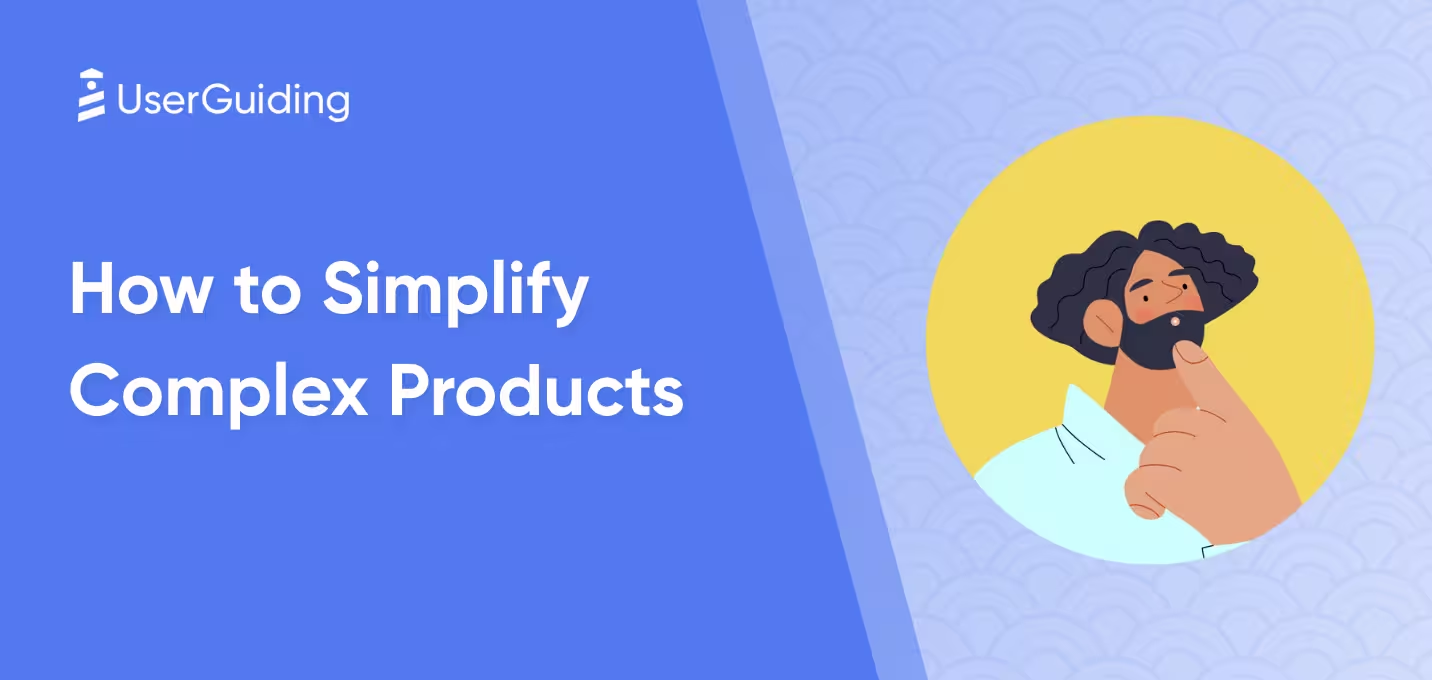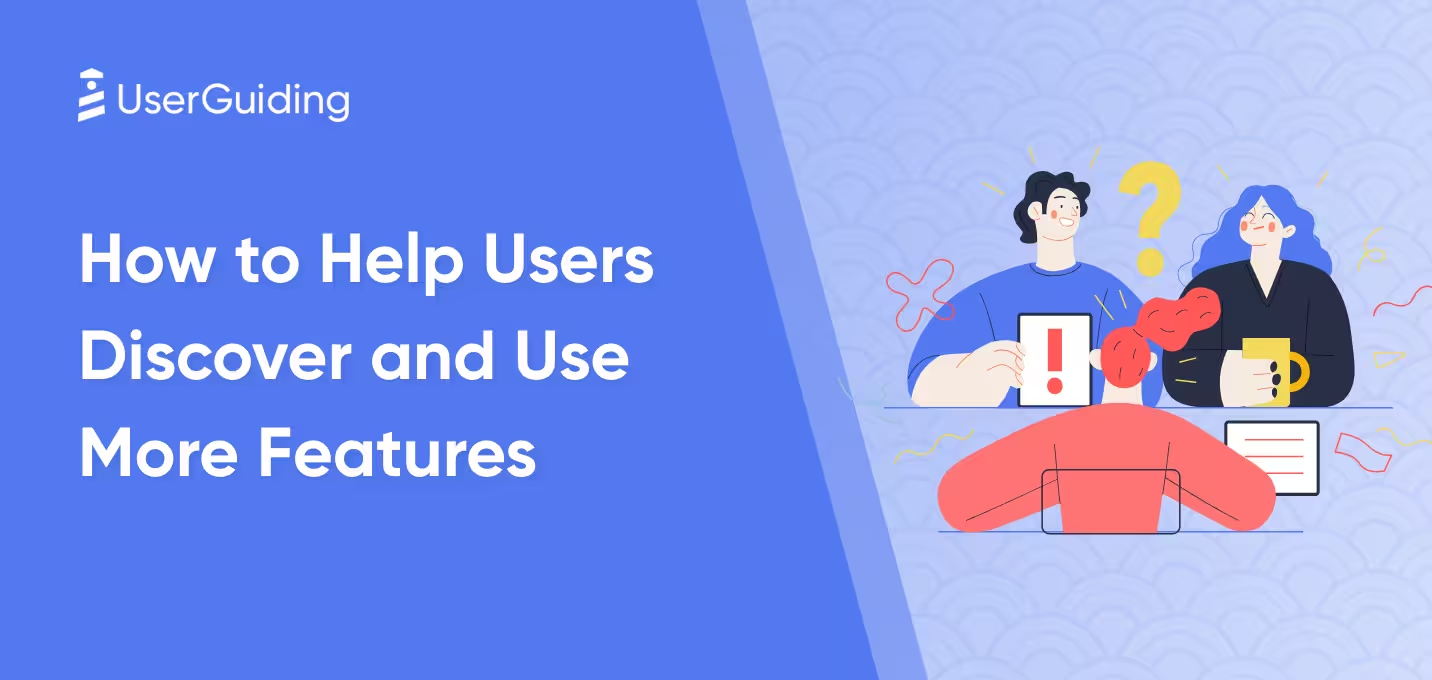

What's your ultimate goal from your product?
Is it:
- To have a product that you think is cool and looks pretty, or
- To get your product adopted by users so that they can use it to solve their problems?
If you said b, congratulations!
Let's be real: there's no point in making a sophisticated, attractive-looking product if no-one's going to use it.
So in this post, we'll delve deep into product adoption, how to measure it at your company and what tools and strategies you can use to boost your adoption rate.
This is going to be a long one, so get comfortable, grab a drink, and let's go!
TL;DR
- Product adoption is when customers use your product regularly to solve a problem they have.
- Improving your product adoption rate will lead to revenue growth, higher retention and more satisfied customers.
- But before adopting your product, a user must first become aware of it, and then become interested enough to try it out.
- You can increase the odds of them doing this by emphasizing the competitive advantage you have over similar products, showing your user that your product is compatible with their needs and lifestyle, and making it as easy as possible to get a free trial.
- The product adoption curve describes how products are gradually adopted by the mass market, starting with the product evangelists and concluding with the laggards.
- To improve your product adoption rate, focus on one niche problem and one niche solution, and make the onboarding and support for your platform as effective and seamless as possible.
- Expect the future of product adoption to be a crazy world of predictive analytics, hyper-personalization in real time and contextual support.
- The best product adoption platform is UserGuiding. If you’re looking to onboarding employees, WalkMe is a decent solution. If you’re looking for product analytics, go with Amplitude.
What is Product Adoption?
Users adopt a product when they use it on a regular basis in order to solve a problem that they have.
Regular doesn't necessarily have to mean frequent. A user can adopt Asana and use it every day to manage projects, but they can also adopt tax software and use it only once a year, during tax season.
Product adoption is more than just acquiring a user. You can acquire a user and not have them do anything with your product. Think of all the millions of Facebook users who never log into their accounts!
The more important point here is that the user both engages with your product and becomes loyal to it. These are both strong long-term predictors of that user being retained – and of your product being a success.
Why Product Adoption Matters
There are many reasons why product adoption is something that companies need to think about. Here are 3 of the most important:
Revenue Growth
Users who adopt your product are much more likely to be paying subscribers than on free trials.
They see value from your product, they use it regularly, it helps them solve a problem – so why wouldn't they pay for it?
The more such users you have, the more your monthly recurring revenue (MRR) will grow.
Retention & Churn Reduction
Users churn when they don't see the point in continuing to use your product, or if they don't understand how to get value from it.
For users who have adopted your solution, neither of those things applies.
On the contrary, they're using your product regularly, which suggests they're getting value out of it. Why would they churn in that situation?
It follows that users who adopt your solution are less likely to churn. So boosting your product adoption rate will also boost your overall retention rate.
If your users are retained for longer, you'll also make more money from each customer over the duration of their time with you. So that means that your Customer Lifetime Value (LTV) will also increase as a result of more users adopting your product.
As Michael Migliore argues in this Linkedin post, the more Value to Customer (VTC) you provide, the more your LTV will increase.
Customer Success
Finally, product adoption is a critical metric for customer success (CS) teams, as well.
The job of CS is to ensure that as many customers experience success with your product as possible.
For larger customers, this sometimes means coming up with a specific success plan for that account, and having an account manager walk with them until their goals are met.
When a customer adopts your product and uses it regularly, that's a huge sign that they're achieving their desired goal, or at the very least working towards it. Why else would they use it?
The 5 Stages of Product Adoption
Every user goes through 5 stages of product adoption, no matter what kind of product it is.
Let’s see what each stage is about and discuss how you can optimize the process.

1. Awareness (Introduction Stage)
In the first stage of the product adoption process, potential customers enter your website to get to know a product, but they don’t have sufficient knowledge about it.
Yet.
The solution is simple: educating customers.
Prospects may not be aware of the existence or importance of a certain problem.
On the other hand, customers may realize the problem but don’t know the solution. Educating customers about either the problem or the solution can help provide the awareness they need.
👉 An important step is making a product more recognizable and making customers aware of it.
Differentiated core features, a better pricing plan, powerful sales, and a clear value proposition with a smooth onboarding process are all very helpful at this stage.
2. Interest (Information-Gathering Stage)
This is the stage where customers are attracted to the product and try to collect more information about it.
👉 Go through the steps potential customers take during this stage. For each step, make sure you offer a good customer experience and have a strong brand, a website that converts, and solid support options.
Segmented email campaigns and conducting customer feedback surveys will increase product adoption at this stage as well.
3. Evaluation (Consideration Stage)
At this stage, customers determine whether a product is worth trying or not.
👉 Help your prospects evaluate your product objectively. Make them see the aspects that differentiate you from alternatives.
Focus on creating a clear product roadmap for acquisition, decreasing customer effort score, especially in the signup and download stages, and collecting valuable feedback, especially from those you couldn’t convert.
4. Trial (Sampling Stage)
Users try your product to see how good it is at delivering value to them.
This can be either the first purchase or a free trial period.
👉 If you can afford to, try to offer free trials and a money-back guarantee to make your customers feel like your product is worth a shot.
Remember, if you don't establish a form of customer loyalty and trust at the trial stage, loyal customers in the future might become a pipe dream.
5. Adoption/Rejection (Buy or not Buy Stage)
At this stage, prospects determine if your SaaS product has value.
Then, they decide whether to adopt it – or not.
Normally, your potential customers who’ve managed to make it to this stage go through 3 sub-stages:
- Cognitive state (being aware and informed)
- Emotional state (liking and preference) and finally,
- Behavioral or conative state (deciding and purchasing)
If these stages are complete as well, congratulations! You have a new addition to your customer base AND a potential loyal customer.
That was all very theoretical, so let me walk you through a practical example.
Real-Life Example of Product Adoption
Let’s assume that you were walking home yesterday after a long day at work. Then, the following happened:
- You saw a billboard saying that a new local pizza place called DeliciousPizza has opened. (Awareness)
- When you got home, you looked for some information on the web to find out more about DeliciousPizza’s menu and prices. (Interest)
- You considered whether you wanted to try it or not. (Evaluation)
- You said what the hell and decided to try a small pizza, just to be safe. (Trial)
- It arrived quickly and was de-li-ci-ous! 😋 So you concluded that DeliciousPizza is now your new go-to pizza place. (Adoption)
What factors influence the adoption process of a new product?
According to Everett M. Rogers, there are 5 factors that influence the adoption of a product.
1- Relative Advantage
Does your product offer better value than your competitors'?
If a user is already using your competitor, they will be more likely to switch if what you offer is better.
2- Compatibility
Does your product match the characteristics of your audience?
Your product should be compatible with the lifestyle of your potential users and take into account the voice of the customer and common customer demands.
3- Complexity
Is your product simple to use?
Customers should not have a hard time using your product; rather, their experience should be as smooth as possible.
4- Trialability
To what extent can users try your product before buying?
If you suspect you might not be able to showcase your value proposition as much as you wish, you might try to expand your freemium plan or free trial period.
5- Observability
How visible is your product to your audience?
You must be present where your audience is present, comment on as much feedback from users as possible, and jump on opportunities for improvement.
What is the Product Adoption Curve?
Do you remember when your family got a computer for the first time?
For some especially tech-savvy families, it might have been before you were born! For others, perhaps it took until some time in the 2000s.
The point I’m making here is this: not every customer will adopt your product at the same rate.
This is true regardless of what market you want to enter. There will always be some people who adopt it faster, and others who take longer.
This concept can be summarized visually by a graph called the product adoption curve:

This is a bell curve, or a normal distribution. Observe how users are divided into 5 groups:
- Innovators: The first 2.5% to try a product.
- Early Adopters: The next 13.5% – the opinion leaders who influence others.
- Early Majority: Another 34% who are deliberate and cautious adopters.
- Late Majority: The next 34% – the people who are skeptical but eventually adopt due to peer pressure.
- Laggards: The final 16% who are resistant to change.
Also notice the stage on the graph that’s marked as “the chasm.”
This is where most companies fail. Lots of products can find early adopters, but only few end up making the transition to becoming a mass-market product.
Those that do have a comprehensive product adoption strategy that’s in line with industry best practices. And speaking of which…
How to Improve Product Adoption
Here are some product adoption best practices that you can learn from.
1. Improve your onboarding
The strength of your onboarding process correlates with how quickly people adopt your product.
The data is clear: even an average customer education program leads to a 38.3% increase in product adoption, together with a 26.2% improvement in customer satisfaction.
So can you imagine what a well-optimized onboarding process would achieve?!
Founder of Product Led, Wes Bush, argues that the best way to improve your onboarding process is to cut out the steps that are slowing users down.
“Go through your onboarding process and ruthlessly cut out unnecessary steps. Email verification is a popular one.
Delay advanced features or complex steps for later, and focus on only the most essential actions that help users hit their first milestone.”
Wes Bush, Product Led
Beyond cutting out email verification, you could also consider:
- Removing superfluous data-gathering questions in your onboarding survey
- Replacing an email sign-up form with a form that allows users to automatically sign up using Google or Facebook
- Stopping highlighting features that aren’t essential for the user to understand in order to activate
Another way to minimize friction in the onboarding process is to provide users with step-by-step guidance.
There are two common methods to do this at the start of the customer journey.
Firstly, you can create a list of the most important elements of your product that a user needs to understand in order to activate, and then create an interactive product guide that walks users through each step, one by one:

Our product adoption trends report found that companies are already using an average of 15 such guides:

Secondly, you can embed that list into a checklist, so that users can see how much they’ve done and feel motivated to take the next step in the checklist.

By the time that the user has finished the checklist, they will have activated – so they will have experienced the value of your product. From there, product adoption won’t be far away.
2. Focus on one niche
Remember the concept of the chasm from the product adoption curve graph?
As we said earlier, jumping the chasm is the hardest stage in the journey of every company seeking mass adoption of their solution.
The concept of the chasm was originally introduced by Geoffrey Moore in his book Crossing the Chasm.
Moore’s proposed solution to help companies cross the chasm and make it to mass adoption? Focusing on one niche market initially.
As this LinkedIn post argues:
“Success lies in finding and dominating a niche market before expanding to [a] broader audience — a strategy as relevant today as when the book was first published.”
And it stands to reason.
As businesses, we only have limited resources. The more we spread those resources over multiple niches, the more watered down our efforts become.
There’s just no way that we can compete with other businesses who are putting all their resources towards dominating one niche.
It’s only once you’ve achieved product-market fit in one niche that you can then start thinking about getting a different user persona to adopt your product to solve a different problem.
3. Engage Users Effectively
Close your eyes for a moment and make a mental picture of the sort of user who is going to adopt your product.
The demographics of that user will vary from business to business.
But what won’t vary is that the user will be consistently engaging with what you do.
This raises the question: how can you intentionally boost user engagement?
By creating opportunities for the user to engage with you, both inside your product and outside it.
For example:
You can send the user in-app surveys that they can respond to:

Provide contextual tooltips which provide more information about a particular product feature when the user mouses over them:

Or notify users about new features or other important updates:

Outside your product, you can also:
- Send personalized email campaigns showing how people just like your user got value out of your product
- Schedule webinars that discuss industry best practices
- Provide opportunities for community engagement on social media and your company’s support center
And while we’re on the subject of support…
4. Support Users Proactively
There are two schools of thought when it comes to supporting your users into adopting your product.
The classic approach is to offer multiple channels for users to get in touch with your team in real time.
I’m talking about email, phone, live chat, and (dare I say it…) even the good old-fashioned postal address!
It’s smart to have at least a couple of these on your contact page, as well as nestling them inside your help resources somewhere.
That being said, there’s a new kid on the block when it comes to supporting your users. And that’s: self-service support.
You see, at some point businesses realized that having users contact support staff to answer questions was incredibly slow and incredibly expensive.
Did you know that the average support salary in the US is now $43k per year? Yikes!
So instead, a growing number of SaaS companies are creating resources that let users answer their own questions, in their own time. It’s much faster – and cheaper too.
I’m talking about solutions like:
An in-app help widget:

An AI chatbot:

A knowledge base:

And it seems that customers approve of this change of direction. According to Zendesk, 67% of customers prefer self-support over speaking with an agent.
Key Metrics to Track while Measuring Product Adoption
Even if you follow all the best practices listed above, you’ll still need to tweak and optimize as you go.
Look to your dashboard and apps like Mixpanel or Clarity to track user behavior and see what you can learn.
In particular, it’s a good idea to track the following on a monthly basis:
- Adoption Rate: The amount of users who achieve a certain product milestone indicating that they derived value from the product.
- Time-to-Value (TTV): How quickly users achieve value from using a product after signing up.
- Trial-to-Paid Conversion Rate: What percentage of trial users end up becoming paid subscribers.
- Feature Adoption Rate: How many users adopt specific features.
- Retention Rate: The percentage of users that continue to return after using your product for the first time.
- Customer Lifetime Value (CLV): The amount of revenue a business can expect to earn per customer over the duration of the customer’s relationship with them.
If you’d like to understand why users are behaving the way they are and uncover qualitative insights behind the above metrics, in-app surveys are a great tool for that.
Top Product Adoption Platforms
So which tools should you use to boost your product adoption rate?
Here are a few of the best ones on the market.
1. UserGuiding

If you’re looking for a way to boost your product adoption rate by improving your onboarding, then UserGuiding is the tool you need.
UserGuiding will let you create onboarding flows such as guides and walkthroughs without code. This is great news, since it means that even your non-technical product team will be able to build onboarding systems – without having to bother your developers.
You can create checklists of the most important onboarding tasks, segment those checklists by user persona, and then assign a checklist to a user during onboarding that matches their needs. Pretty neat, right?
If your users get stuck, there’s no need to support them manually. Instead, you can build self-service support systems, like a knowledge base and a help center, and watch as your users solve their own problems in real time.
UserGuiding recently even added an AI assistant tool. So if you want to create a first port of call for your users that can answer simple questions based on your knowledge base, even that doesn’t require code these days.
Pricing starts from $174 per month. Grab a free trial today!
2. Pendo

Pendo is a product analytics platform. If you’re looking for a way to gain deeper insights into your user behavior, what leads users to adopt your solution and what leads them to churn, this is the platform for you.
Pendo’s analytics are among the most sophisticated in the market. You can use them to see where users dropped off in particular flows, and then intervene by creating a guide to point them in the right direction.
If you’d like some qualitative data to understand the “why” behind the numbers, Pendo will also let you create in-app surveys so that you can delve deeper into individual product use cases.
Going further still, Pendo provides session replay functionality similar to Hotjar, so you can literally watch each individual session, if you so choose.
The only problem here is that there is so much technical detail and so much data that it’s easy to lose sight of the woods for the trees. You’ll probably have to assign at least one person to Pendo to make it worth your investment.
And speaking of investment, Pendo doesn’t share pricing publicly, but we’ve heard that it’s more geared towards enterprises than small businesses.
3. WalkMe

But what if you’re looking to get your employees to adopt your software internally? For that use case, WalkMe is a good fit for your needs.
With WalkMe, you can build intricate guides that show your employees how to get the most out of complex pieces of internal software. The guides will show them common mistakes, point them towards the most important features, and even automate some simple tasks to reduce human error.
Want to see how your employees are using your tool? WalkMe has analytics for that. You can use them to uncover where employees are getting lost, or which parts of your software are being underutilized.
As you might expect from a tool that’s owned by SAP, WalkMe comes with a million and one different integrations – so expect it to integrate natively with the majority of the tools in your stack.
Downsides? This tool is unintuitive and hefty to learn – probably because it tries to do so much at once. And the pricing isn’t for the faint-hearted, either.
4. Appcues

Appcues is the oldest onboarding tool on the market. In the decade or so they’ve been in business, they’ve had plenty of time to develop powerful features that can help you get more users to adopt your product.
Like UserGuiding, Appcues will let you build onboarding elements like guides, modals, tooltips and product announcements without having to code.
Like UserGuiding, it also comes with a solid analytics suite so that you can measure the effectiveness of your product adoption efforts. The analytics are quite fancy, allowing you to track events without code and send detailed reports to your management team.
The biggest differentiator here is that Appcues allows you to onboard mobile users. This is a rare feature in this industry, so if you’re building a mobile app, Appcues is going to be tough to beat. Might also be true if you’re building an app that’s multi-platform.
The challenge with Appcues is that you’ll need to assign a developer to it in order to get the most valuable. It’s not always the easiest platform to use or customize. And this kind of defeats the point of having a no-code tool, in our opinion.
At prices starting from $249 per month, it’s less expensive than some of the enterprise tools on this list, but still not super cheap.
5. Chameleon

Chameleon is another user onboarding tool.
Similar to the other tools we’ve discussed, it can help you boost your product adoption with product tours, checklists, and in-app surveys.
The product analytics side of Chameleon is ok for tracking the number of user interactions with a particular onboarding element, but fairly rudimentary compared to Pendo and Appcues.
Chameleon’s AI assistant feature is quite good. It can answer commonly asked questions and can even give interactive tutorials that match the context where the question was asked. The more your users interact with it, the more this AI assistant improves through machine learning.
Chameleon also comes with an unusual helpbar feature. This allows users to search through your product by pressing Ctrl-K – entirely for free. No other tool on the market provides a solution like this.
This tool is not especially easy to learn or implement, but provides a decent product adoption solution if you can get past that hurdle. Pricing starts from $279 per month.
6. Whatfix

Think of Whatfix as a mash-up of Appcues and WalkMe. In other words: it’s a tool for enterprises that tries to cover both the user onboarding and the employee onboarding use cases at the same time.
If you have a massive platform with a complicated user base that spans both customers and internal users, this could well be the tool for you. Whatfix will let you build interactive walkthroughs and task lists for employees and users alike.
In addition, Whatfix serves as a central hub for all your learning resources, such as your knowledge base, help documentation, and downloadable pdfs. Keeping this information accessible is good for self-service support, and you can even do this across different languages at the same time!
Want to see how your onboarding efforts are going? Whatfix has decent analytics as well, encompassing product analytics, predictive analytics and user feedback tools like NPS surveys.
Like WalkMe, Whatfix have tried to cover so many different use cases on one platform that their software is sluggish and not especially user-friendly. The pricing is not shared publicly, but we hear that it runs into 5 figures per year.
7. Gainsight PX

Gainsight PX is one part of the larger Gainsight software suite that’s focused on improving your user onboarding with product walkthroughs.
The bread and butter of this product lies in creating onboarding flows and collapsible knowledge bases called knowledge centers. The former are great for showing new clients the ropes on their first day, while the latter can be seen as a type of knowledge base that can live unobtrusively inside your product.
More unusually, Gainsight PX has a product mapping feature which allows you to visualize your entire product, complete with all its flow and moving parts. This is really helpful for companies that want to see the bigger picture of their product adoption journey – and work out any kinks in the process.
Gainsight PX’s analytics are ok, but only ok. For a deeper level of analysis, it’s better to use their sister tool, Gainsight CS.
Gainsight doesn’t share pricing publicly, but reviews online suggest this is an expensive product to deploy and maintain. Expect to have to use a developer as well.
8. Intercom

Intercom is an AI-powered customer success tool.
It’s best known for its chatbot, Fin, which can be used to answer simple questions without requiring human input. This is one of the best chatbots in the industry – it’s got to the point that it can even handle more complex scenarios if you give it sufficient training on a large enough data set.
On the human side of customer success, Intercom also has a helpful ticketing system which enables you to deal with all the inquiries from your customers in one place – and then respond on whichever channel suits the situation best.
You can use Intercom to make simple product tours as well, but they have the unfortunate reputation in this industry of being rather linear and mundane. Likewise, Intercom’s NPS survey and analytics features are quite basic as well compared to the other tools in this article.
Intercom’s pricing starts from $39 per seat per month, which seems cheap. But this comes with a big caveat – most of the features that are really essential for product adoption (like product tours, surveys, checklists and A/B testing) require an add-on which costs an extra $99 per month.
And are you really going to just use the one seat for a customer-facing tool like this? Seems unlikely – so expect the price to rise steeply as you scale.
9. Heap

Heap’s product analytics software is used by over 6000 businesses worldwide – so clearly they’re doing something right.
The software tracks events that include clicks, video plays, image views and scrolling. Unlike a lot of its competitors, you don’t need to manually choose which events Heap should track. It simply tracks everything by default.
Your job, then, becomes creating the reports that will give you the insights you need in order to make your product adoption process more effective. Note that you can even download these reports retroactively, which is an unusual perk.
But there’s a catch: the amount of data Heap retains over time is driven by which plan level you pay for. It starts at only 3 months of data for the free plan.
This means that Heap scales less well than some of the other product analytics tools we’ve covered in this article.
That being said, the tool is extremely easy to use, and there is a generous free version that can cover up to 50k sessions a month – provided you’re willing to put Heap’s logo on your site.
10. Amplitude

If you’re looking for an analytics platform to boost your product adoption rate with some helpful data, you could do worse than look at Amplitude. This software is the second most popular analytics software in the world, after Google Analytics.
Amplitude is great for understanding how people are using your products, and uncovering areas where improvements can be made.
For example, it will show you where in a particular flow users tend to abandon the process, or which UI elements get clicked on the least.
Having found these weak points, you could then use a paid add-on to send specific user segments in-app messages to boost engagement. Pretty neat, right?
Your boss is also very likely to love Amplitude, simply because of the quality of the data visualizations you can make with it. If you can imagine a custom report, you can probably make it for your boss with Amplitude.
Again though, the best reports are hidden behind a paywall.
Noticing a pattern here? Amplitude is a phenomenal tool and deserves all the plaudits it receives, but its best features are only available on its premium plans.
That being said, the free version is very easy to use and can track 10 million sessions per month of data, so that should keep you busy for a while!
How to Choose the Right Platform
So how do you know which of these platforms is right for your business?
First, evaluate your needs. Do you need an onboarding tool? If so, do you need it to onboarding users, or employees?
Or perhaps you need a product analytics platform to strengthen the data side of your product adoption drive?
Consider scalability – how well does the product’s pricing scale as you grow? There’s no use handcuffing yourself to an important element of your tech stack, only to have to rip it out later when you outgrow it!
Speaking of tech stack, check your other key tools that support your product infrastructure. Do they integrate natively with the tool you want to use?
If not, you could use something like Zapier as a workaround, so it’s not necessarily a dealbreaker, but bear in mind that this will cost additional time and money.
Finally, how technical is your team? If you’re all developers, a technical platform won’t be an issue. But if you’re more of a product marketing team, then having some sort of no-code solution will be essential.
Future Trends in Product Adoption
So what does the future hold for the world of product adoption?
Here we explore 4 of the hottest trends that you can expect to see develop over the coming decade.
1. Hyper-Personalized Onboarding
Companies are already personalizing their onboarding to the needs of each customer segment.

Simply get your customer to fill in a few segmentation questions during the welcome flow, assign them to a segment based on their answers, and then customize the onboarding materials they see depending on the goals of their segment.
Over the next few years, expect this personalization to increasingly reach the level of the individual, with companies tailoring every aspect of the onboarding journey to individual users based on their behavior, preferences, and goals.
Using cutting-edge AI, businesses will get better and better at predicting user behavior and segmenting them accordingly – often on the basis of existing user data.
Expect to see companies customizing product tutorials and introductions to features in real-time, based on how customers are interacting with their products.
If this sounds wacky to you, it seems like you’re in the minority. In general, users feel valued and understood when companies personalize the products they use to their needs.
And we’re already well on our way to this brave new world: Salesforce found that 73% of customers say that companies are treating them like an individual instead of a number – up from 39% in 2023.
2. Increased Use of AI and Machine Learning
With the rise of ChatGPT, AI is slowly (or not so slowly) taking over the world.
Every industry is affected in some way – even the world of product adoption.
Expect to see more and more companies investing in AI-powered chatbots that can provide instant support 24/7 – the perfect hands-off way to help your customers adopt your product.
You can also expect machine learning to become more and more essential, as businesses develop predictive analytics solutions which can predict users’ needs and recommend them features accordingly.
Customer success departments will also use predictive analytics to predict which users will churn… and then stop them churning in real time!
Sounds like science-fiction, but it’s already starting to happen!
And it makes sense from a user perspective. We all love it when products give us exactly what we need, immediately.
It’s just another way to reduce Time-to-Value and discover the features we need.
3. No-Code and Low-Code Tools for Adoption
Back in the day, when you wanted to build onboarding systems to help your customers adopt your technology, you had to build them in-house.
This was immensely expensive and time-consuming. Developers aren’t exactly cheap, and every developer creating a tooltip for onboarding was one who couldn’t be used to build your core product features.
Only the big enterprises could really afford this sort of in-house, bespoke onboarding.
But this is already changing. Tools like UserGuiding enable non-technical product teams to build modals, hotspots, in-app surveys, knowledge bases and more — without having to write a line of code themselves.
These tools often function using a simple drag-and-drop interface, which can be learned in a matter of minutes.
Over the next few years, expect no-code onboarding tools to become increasingly mainstream, radically speeding up product iteration cycles and reducing our collective reliance on developers.
4. Contextual and Embedded User Support
We already discussed how support is moving away from traditional media like phone and email towards self-service options.
But there’s another trend to comment on here: one which is even more futuristic-sounding.
Imagine you’re using a product and you’re stuck.
In that exact moment, a micro-learning module pops up to show you what to do.

The support is contextual – meaning that it shows up at the point that you need it, in the exact context that you need it.
Such support is driven by (you guessed it!) AI and geared to provide answers on the basis of user behavior.
From the user’s perspective, this type of support involves less friction than reading a static FAQs page, and empowers them to solve their own problems more efficiently.
Unlocking the Power of Product Adoption
Are you ready to unlock the power of product adoption for your own business?
Rather than trying to reinvent the wheel and build all your own onboarding materials from scratch, it’s smarter to partner with a company that’s helped thousands of businesses like yours boost their product adoption rate.
I’m talking about UserGuiding: the no-code way to build knowledge bases, in-app surveys, AI assistants, hotspots, tooltips and more!
That type of onboarding muscle is now available for less than the cost of an Apple charger.
And if you want to be sure it will help you, you can even try it entirely for free.
Frequently Asked Questions
What are the five stages of the new product adoption curve?
The Innovators - The Early Adopters - The Early Majority - The Late Majority - Laggards. All stages are explained in our article.
What is the most efficient way to increase product adoption?
A product adoption software saves your developers' time and your budget and permits your team to follow the product adoption process stages.
What metrics should I follow to measure the success of product adoption?
The adoption rate of the product, time-to-first key action, percentage of the users that have reached the "aha!" moment.
What is the product adoption process?
The product adoption process encompasses the vital steps users take while discovering, exploring, interacting with, and eventually embracing a new product or service. Grasping and efficiently managing this process is essential for businesses to guarantee triumphant product launches, elevated user satisfaction, and enduring customer loyalty. Typically, the product adoption process unfolds through five primary stages:
1- Awareness
2- Interest
3- Evaluation
4- Trial
5- Adoption

















.svg)
.svg)
.svg)
.svg)
.svg)

.svg)
.svg)












.svg)
.svg)




.png)


